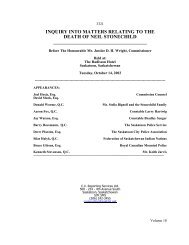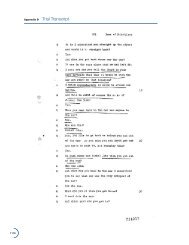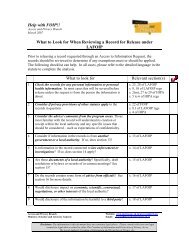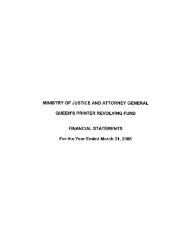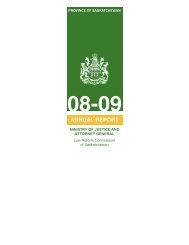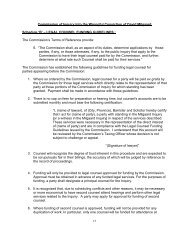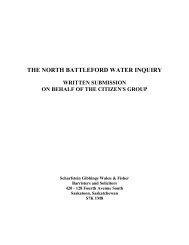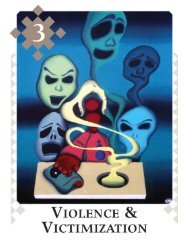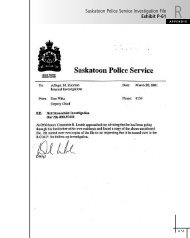Appendix K Memorandum of Law - s. 9(2) of the Canada Evidence Act
Appendix K Memorandum of Law - s. 9(2) of the Canada Evidence Act
Appendix K Memorandum of Law - s. 9(2) of the Canada Evidence Act
Create successful ePaper yourself
Turn your PDF publications into a flip-book with our unique Google optimized e-Paper software.
<strong>Appendix</strong> K <strong>Memorandum</strong> <strong>of</strong> <strong>Law</strong><br />
2 C.C.C. 380 (N.S. C.A.); but see Regina v. Gushue (No. 4) (1975), 30 C.R.N.S. 178 (Ont.). The majority <strong>of</strong> <strong>the</strong><br />
Ontario Court <strong>of</strong> Appeal in Wawanesa recognized that this was <strong>the</strong> prevailing view but decided that <strong>the</strong> same<br />
word in <strong>the</strong> Ontario counterpart to section 9 should be given a broader interpretation to include not only hostility<br />
but also opposition in interest to <strong>the</strong> party calling him. That Court went on to conclude that evidence <strong>of</strong> a prior<br />
inconsistent statement could be taken into account in determining adversity [under section 9(1)]: see Regina v.<br />
Collerman, 43 C.R. 118, 46 W.W.R. 300, [1964] 3 C.C.C. 195 (B.C. C.A.), taking a similar position in a criminal<br />
case. Despite <strong>the</strong> seeming circularity <strong>of</strong> such a position I suggest that a similar position now exists in federal<br />
matters by virtue <strong>of</strong> section 9(2). I recognize that some believe that subsection 9(2) is a new procedure<br />
for discrediting a witness, completely independent <strong>of</strong> subsection 9(1), but I suggest it is merely a<br />
preliminary device to enable counsel to demonstrate <strong>the</strong> adversity mentioned in 9(1) which might <strong>the</strong>n<br />
permit pro<strong>of</strong> <strong>of</strong> <strong>the</strong> prior statement. If my suggestion is correct <strong>the</strong>n (despite Regina v. Milgaard, 14<br />
C.R.N.S. 34, [1971] 2 W.W.R. 266, 2 C.C.C. (2d) 20, leave to appeal refused C.C.C. (2d) 566n (Can.)) <strong>the</strong><br />
cross-examination mentioned in s. 9(2) ought to take place in <strong>the</strong> absence <strong>of</strong> <strong>the</strong> jury and if <strong>the</strong> trial<br />
judge on witnessing that cross-examination concludes that <strong>the</strong> witness is adverse <strong>the</strong> party may ask<br />
his leave to prove <strong>the</strong> statement in front <strong>of</strong> <strong>the</strong> jury. To permit such cross-examination in <strong>the</strong> presence<br />
<strong>of</strong> <strong>the</strong> jury, as Milgaard suggests, appears to make s. 9(1) largely redundant as counsel may <strong>the</strong>reby<br />
normally accomplish what he seeks without <strong>the</strong> necessity <strong>of</strong> any ruling <strong>of</strong> adversity. I am reinforced in<br />
this view by <strong>the</strong> concluding words <strong>of</strong> s. 9(2) that: ‘<strong>the</strong> court may consider such cross-examination in determining<br />
whe<strong>the</strong>r in <strong>the</strong> opinion <strong>of</strong> <strong>the</strong> court <strong>the</strong> witness is adverse’. If we are to seek Parliament’s intention we might also<br />
consider <strong>the</strong> remarks <strong>of</strong> <strong>the</strong> <strong>the</strong>n Minister <strong>of</strong> Justice, Mr. Turner, and <strong>the</strong> <strong>the</strong>n director <strong>of</strong> <strong>the</strong> Criminal <strong>Law</strong> Section,<br />
Mr. Scollin, when <strong>the</strong>y appeared before <strong>the</strong> Standing Committee on Justice and Legal Affairs (28th January<br />
1969). Those remarks also provide what McWilliams terms <strong>the</strong> ‘unaccountable reason’ for confining s. 9(2) to<br />
statements in writing: see McWilliams on <strong>Evidence</strong> at p. 611. 59<br />
By focusing on <strong>the</strong> conundrum surrounding <strong>the</strong> operation <strong>of</strong> s. 9(1) <strong>of</strong> <strong>the</strong> CEA and <strong>the</strong> conflicting<br />
jurisprudence that prompted <strong>the</strong> enactment <strong>of</strong> s. 9(2), Judge Delisle’s comments seem to grasp <strong>the</strong><br />
relationship that Parliament intended for ss. 9(1) and (2) and s. 9(2)’s intended function as a remedial<br />
provision designed to enhance <strong>the</strong> operation <strong>of</strong> s. 9(1). 60 Indeed, Judge Delisle’s assessment provides a<br />
coherent and integrated approach between <strong>the</strong> two provisions that accounts for <strong>the</strong> judicial interpretation<br />
surrounding s. 9(1) <strong>of</strong> <strong>the</strong> CEA and <strong>the</strong> historical circumstances surrounding <strong>the</strong> enactment <strong>of</strong> s. 9(2).<br />
However, Judge Delisle’s view <strong>of</strong> <strong>the</strong> legislation did not become <strong>the</strong> accepted position in <strong>Canada</strong>. 61<br />
Ra<strong>the</strong>r, s. 9(2) <strong>of</strong> <strong>the</strong> CEA has been construed as an independent procedure under which a judge could,<br />
59 Emphasis added. R. Delisle, “Witnesses – Now and Later” (1976), 34 C.R.N.S. 1 at p. 4 (“Witnesses – Now and<br />
Later”). Judge Delisle reiterated <strong>the</strong>se comments in Competence and Credibility, supra note 58 at p. 346.<br />
60 As stated in Driedger, supra note 8 at p. 41: “… in <strong>the</strong> context <strong>of</strong> reform legislation <strong>the</strong> intention to reform can only<br />
be understood in terms <strong>of</strong> existing law and <strong>the</strong> mischief or defect for which <strong>the</strong> law did not provide. The primary<br />
interpretive challenge, <strong>the</strong>n, is to master <strong>the</strong> relationship between <strong>the</strong> new rules and existing law. And in keeping with<br />
this concern <strong>the</strong> primary interpretive values are integration, continuity and coherence.”<br />
61 Judge Delisle acknowledged that his view was in <strong>the</strong> minority in his case comment on R. v. McInroy & Rouse, [1979]<br />
1 S.C.R. 588, “Cross-examination <strong>of</strong> Own Witness on Previous Inconsistent Statement – s. 9(2) <strong>Canada</strong> <strong>Evidence</strong><br />
<strong>Act</strong>” (1978-79), 21 Crim. L.Q. 162 at p. 163:<br />
There were formerly two views regarding <strong>the</strong> purpose <strong>of</strong> s. 9(2) <strong>of</strong> <strong>the</strong> <strong>Canada</strong> <strong>Evidence</strong> <strong>Act</strong> and <strong>the</strong> consequent<br />
procedure to be followed in its application. The majority view (e.g., R. v. Milgaard (1971), 2 C.C.C. (2d) 206), 14<br />
C.R.N.S. 34 (Sask. C.A.); R. v. Tom (1976), 3 W.W.R. 391 (Man C.A.)) is that <strong>the</strong> subsection is an independent device<br />
open to counsel to explore inconsistencies between present testimony and a previous written statement and that<br />
such exploration through cross-examination ought to take place in <strong>the</strong> presence <strong>of</strong> <strong>the</strong> jury. The o<strong>the</strong>r view (e.g.,<br />
R. v. Cronshaw and Dupon (1976), 33 C.C.C. (2d) 183 (Ont. Prov. Ct.); R. Delisle, ‘Witnesses – Competence and<br />
Credibility’, 16 Osg. Hall L.J. 337 (1978)) is that <strong>the</strong> subsection only provides a technique for gaining a declaration <strong>of</strong><br />
adversity under s. 9(1) and that <strong>the</strong> cross-examination spoken <strong>of</strong> in s. 9(2) <strong>the</strong>refore should take place in <strong>the</strong> absence<br />
<strong>of</strong> <strong>the</strong> jury; if <strong>the</strong> witness is declared adverse <strong>the</strong>n, and only <strong>the</strong>n, <strong>the</strong> witness may be cross-examined in <strong>the</strong> presence<br />
<strong>of</strong> <strong>the</strong> jury. The decision in this case is clearly in favour <strong>of</strong> <strong>the</strong> majority view and is <strong>the</strong>refore a welcome settlement <strong>of</strong><br />
<strong>the</strong> dispute.<br />
2592



